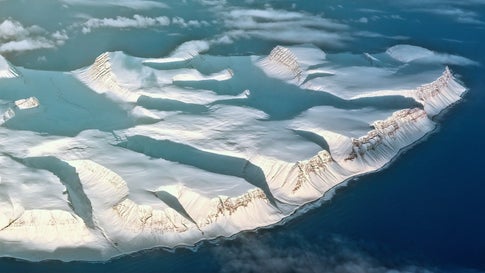(单词翻译:单击)
Plastic snow falls from the sky
北极已经下起了“塑料雪”?
When you think of the Arctic, you imagine an icy land of pure white snow. Others imagine it as the last really clean place left on Earth. We have polluted the deepest oceans with plastic trash, and now, CNN says, "It's the Arctic's turn."
当想到北极,你会想象到一片被白雪所覆盖的冰原。还有一些人会认为那是地球上最后一块净土。我们的塑料垃圾已经污染了海洋最深处,而如今,据美国有线电视新闻网报道,“这次轮到北极了。”
German scientists have recently found microplastics in Arctic snow, the Associated Press reported. Microplastics are pieces of plastic smaller than 5 millimeters. Sadly, the scientists found 1,800 pieces of microplastic per liter of snow.
据美联社报道,德国科学家近期在北极的积雪中发现了微塑料。微塑料是指小于5毫米的塑料颗粒。令人难过的是,科学家们发现每升雪中含有1800个微塑料颗粒。
How is plastic pollution reaching the Arctic? According to scientists, "It's readily apparent that the majority of the microplastic in the snow comes from the air." They fall off of plastic objects and are moved by the wind, just like dust. They mix with ice in the air and fall to the ground as snow. Finding these plastics in Arctic snow means that we may breathe them in. An even higher amount of microplastic was found in the snow around cities.
这些塑料污染物是如何到达北极的呢?科学家们认为,“积雪中的大部分微塑料明显来自于大气。”这些颗粒从塑料物体上脱落,和尘埃一样随风飘到各处。它们与大气中的冰晶结合,通过降雪落到地面上。在北极的积雪中发现这些塑料意味着我们或许会将其吸入体内。城市周边的积雪中还发现了更多微塑料。
The high concentrations found in snow samples suggest microplastics, which contain rubber or chemicals used in synthetic fabrics, may cause significant air pollution.
微塑料中含有用于合成纤维的橡胶和化学物质,而积雪样本中发现了高浓度微塑料意味着这或许会导致严重的空气污染。

Are they bad for us? Scientists cannot answer this question for now, according to the World Health Organization. We do know that our bodies cannot take in "large" pieces of microplastics. However, if the plastics are small enough, they can find ways into our bodies and stay there for a long time, which can be bad for our health. What's more, earlier studies have shown that microplastics may contribute to lung cancer risk, heightening the need to further assess the risks of taking them in, the study said.
这些微塑料对人体有害吗?世界卫生组织认为,科学家们目前还无法回答这个问题。我们都知道身体无法吸收“大颗粒”的微塑料。但如果这些塑料颗粒足够微小的话,它们就能够进入人体,并长期存在于人体内,对健康产生不利影响。此外,先前的研究还表明,微塑料或许会增加肺部癌变的风险,该研究显示,需要进一步评估吸入这些微塑料的风险。
Microplastics have also been found in rivers and oceans around the world. Previous research has found that they flow over long distances and into our oceans, damaging ecosystems along the way. They start in our wastewater, when we wash clothes with plastic fibers. The wastewater then flows into rivers and out to sea, where they are eaten by sea animals. If people then eat these animals, it means that we're eating the plastic as well.
全球的河流和海洋中也发现了微塑料。先前的研究发现,它们漂了很远的距离进入海洋,所到之处破坏生态系统。当我们洗涤的衣服中含有塑料纤维时,微塑料便会残留在污水中。这些污水之后流入江河和海洋,并被海洋生物摄入。如果人们食用了这些海洋生物,也就意味着我们也摄入了塑料。


